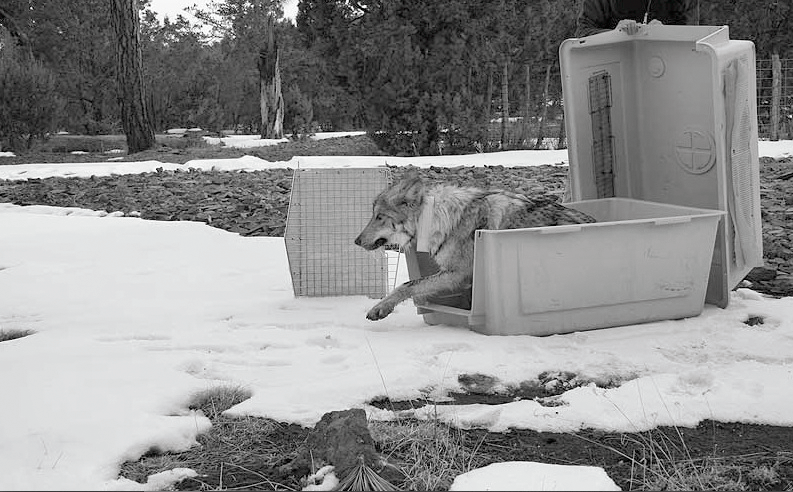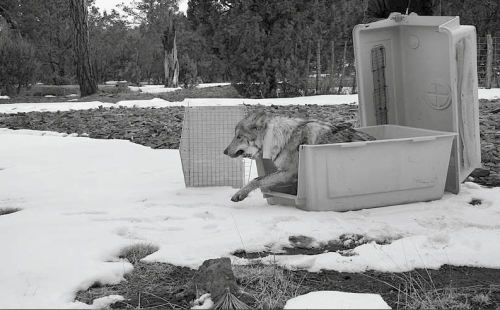
Who’s afraid of the big bad wolf? As it turns out: a lot of people in Tombstone are. The U.S. Fish and Wildlife Service is considering an expansion of the Mexican Wolf Blue Range Reintroduction Project in Cochise County, and some are raising concerns.
The proposed change would mean that the area of land on which Mexican wolves are allowed would be expanded—part of it reaching into Tombstone.
The new zoning would include all of the area in Arizona and New Mexico between Interstate 10 and Interstate 40.
Meetings have been held in both states to gauge reactions and gather public comment on the issue. And the Tombstone Unified School District has weighed in, expressing opposition to the expansion in a letter to the U.S. Fish and Wildlife Service, saying in part:
“Tombstone Unified School District is a rural area where many of our students walk a sizeable distance to and from school bus stops and have to wait for the bus in isolated areas. Wildlife is very abundant at many of our school bus stops. Tombstone Unified School District Governing Board feels the introduction of predators like the Mexican Gray wolf would be a very real danger to our students, particularly the younger ones.”
The wolves average about five and a half feet in length and weigh between 50 and 80 pounds, according to the Arizona Game and Fish Department website. Mike Hayhurst, a school board member and rancher in Tombstone, is worried for the safety of the community. He said he has had personal experience with the wolves; he led tour groups through some of the wolf territory shared with New Mexico. Most of the wolves in the range were bred in captivity, and he feels they are more dangerous to humans than wild-bred animals.
His experience is reflected in the school board letter:
“This statement is particularly true with wolves who have been raised with human contact. We have been informed these wolves present no danger to humans but this is not true. Members of our school board and school administration have had contact with these wolves in New Mexico and Northern Arizona and they showed little to no fear of humans.”
Bruce Sitko, a specialist at the Arizona Game and Fish Department, said that since the program was introduced in 1998, there hasn’t been a single incident of a wolf attacking a human. He said the wolves are not a danger to humans; they are simply inquisitive.
“What I can tell you with the Mexican Wolf—there has not been an attack,” Sitko said. “The wolves tend to be curious. If they see someone, they will sit back on their hind legs and observe, and some people see their interest as threatening.”
But Karl Uterhardt, Tombstone Unified School District’s superintendent, said he is not willing to take a risk. He said safety is his main priority. Students often have to walk a distance to get from home to class, and he is worried that the wolves would create danger.
“If one kid gets hurt, that’s too many,” Uterhardt said.
And Hayhurst agreed. “I don’t want to take the chance,” he said. “The experimental reintroduction has gone far enough.” Hayhurst said the project should maintain its current boundaries. A ranger, he also said he is worried about wolves attacking livestock and hurting Tombstone economically.
“Ranchers are a big part of the economy in Tombstone,” Hayhurst said. “If a wolf attacks an animal, that is hard to prove. So it is often hard for ranchers to be reimbursed.”
Buckley said that the government would assist ranchers if they lose animals to the wolves. But it can be hard to prove a wolf killed an animal.
Hayhurst said having livestock and acres of land means that he might not see some of his animals for considerable periods of time. If an animal were killed, whatever killed it would be long gone by the time anyone noticed.
Tom Buckley, a spokesman for the U.S. Fish and Wildlife Service, said the agency is interested in hearing the ideas that residents have.
“We don’t claim to have all the answers,” Buckley said. “If somebody out there can help us come up with a solution, we are more than willing to listen.”
However, the meetings are coming to an end. The last one is scheduled for Dec. 17. The U.S. Fish and Wildlife Service will ultimately make the final decision and, as of now, it appears likely that the expansion will be approved. Buckley said a decision will be reached in early 2014 but it would still take a full year before the changes become a reality. But the Tombstone Unified School District remains insistent in their opposition, stating:
“With our rural location, distance students walk to and from school bus stops, and the fact that these wolves are large-scale predators, we do not support the introduction of them into Cochise County Arizona.”


